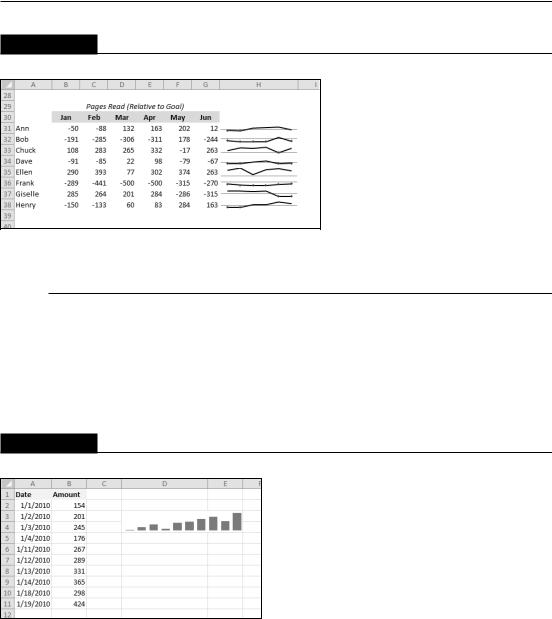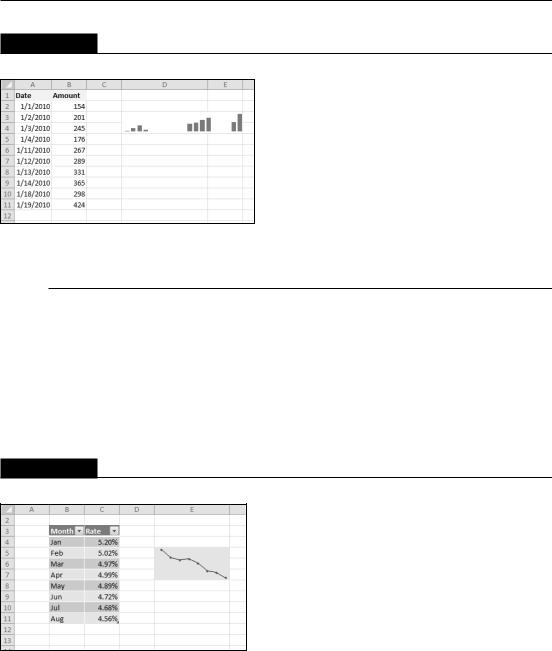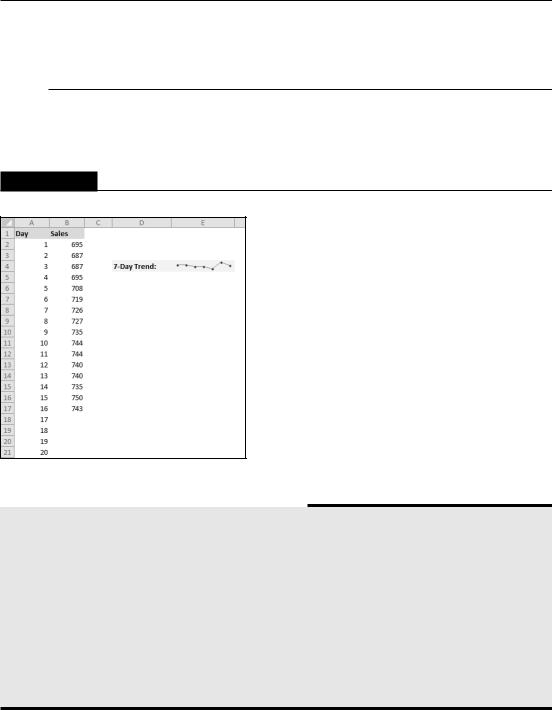
- •About the Author
- •About the Technical Editor
- •Credits
- •Is This Book for You?
- •Software Versions
- •Conventions This Book Uses
- •What the Icons Mean
- •How This Book Is Organized
- •How to Use This Book
- •What’s on the Companion CD
- •What Is Excel Good For?
- •What’s New in Excel 2010?
- •Moving around a Worksheet
- •Introducing the Ribbon
- •Using Shortcut Menus
- •Customizing Your Quick Access Toolbar
- •Working with Dialog Boxes
- •Using the Task Pane
- •Creating Your First Excel Worksheet
- •Entering Text and Values into Your Worksheets
- •Entering Dates and Times into Your Worksheets
- •Modifying Cell Contents
- •Applying Number Formatting
- •Controlling the Worksheet View
- •Working with Rows and Columns
- •Understanding Cells and Ranges
- •Copying or Moving Ranges
- •Using Names to Work with Ranges
- •Adding Comments to Cells
- •What Is a Table?
- •Creating a Table
- •Changing the Look of a Table
- •Working with Tables
- •Getting to Know the Formatting Tools
- •Changing Text Alignment
- •Using Colors and Shading
- •Adding Borders and Lines
- •Adding a Background Image to a Worksheet
- •Using Named Styles for Easier Formatting
- •Understanding Document Themes
- •Creating a New Workbook
- •Opening an Existing Workbook
- •Saving a Workbook
- •Using AutoRecover
- •Specifying a Password
- •Organizing Your Files
- •Other Workbook Info Options
- •Closing Workbooks
- •Safeguarding Your Work
- •Excel File Compatibility
- •Exploring Excel Templates
- •Understanding Custom Excel Templates
- •Printing with One Click
- •Changing Your Page View
- •Adjusting Common Page Setup Settings
- •Adding a Header or Footer to Your Reports
- •Copying Page Setup Settings across Sheets
- •Preventing Certain Cells from Being Printed
- •Preventing Objects from Being Printed
- •Creating Custom Views of Your Worksheet
- •Understanding Formula Basics
- •Entering Formulas into Your Worksheets
- •Editing Formulas
- •Using Cell References in Formulas
- •Using Formulas in Tables
- •Correcting Common Formula Errors
- •Using Advanced Naming Techniques
- •Tips for Working with Formulas
- •A Few Words about Text
- •Text Functions
- •Advanced Text Formulas
- •Date-Related Worksheet Functions
- •Time-Related Functions
- •Basic Counting Formulas
- •Advanced Counting Formulas
- •Summing Formulas
- •Conditional Sums Using a Single Criterion
- •Conditional Sums Using Multiple Criteria
- •Introducing Lookup Formulas
- •Functions Relevant to Lookups
- •Basic Lookup Formulas
- •Specialized Lookup Formulas
- •The Time Value of Money
- •Loan Calculations
- •Investment Calculations
- •Depreciation Calculations
- •Understanding Array Formulas
- •Understanding the Dimensions of an Array
- •Naming Array Constants
- •Working with Array Formulas
- •Using Multicell Array Formulas
- •Using Single-Cell Array Formulas
- •Working with Multicell Array Formulas
- •What Is a Chart?
- •Understanding How Excel Handles Charts
- •Creating a Chart
- •Working with Charts
- •Understanding Chart Types
- •Learning More
- •Selecting Chart Elements
- •User Interface Choices for Modifying Chart Elements
- •Modifying the Chart Area
- •Modifying the Plot Area
- •Working with Chart Titles
- •Working with a Legend
- •Working with Gridlines
- •Modifying the Axes
- •Working with Data Series
- •Creating Chart Templates
- •Learning Some Chart-Making Tricks
- •About Conditional Formatting
- •Specifying Conditional Formatting
- •Conditional Formats That Use Graphics
- •Creating Formula-Based Rules
- •Working with Conditional Formats
- •Sparkline Types
- •Creating Sparklines
- •Customizing Sparklines
- •Specifying a Date Axis
- •Auto-Updating Sparklines
- •Displaying a Sparkline for a Dynamic Range
- •Using Shapes
- •Using SmartArt
- •Using WordArt
- •Working with Other Graphic Types
- •Using the Equation Editor
- •Customizing the Ribbon
- •About Number Formatting
- •Creating a Custom Number Format
- •Custom Number Format Examples
- •About Data Validation
- •Specifying Validation Criteria
- •Types of Validation Criteria You Can Apply
- •Creating a Drop-Down List
- •Using Formulas for Data Validation Rules
- •Understanding Cell References
- •Data Validation Formula Examples
- •Introducing Worksheet Outlines
- •Creating an Outline
- •Working with Outlines
- •Linking Workbooks
- •Creating External Reference Formulas
- •Working with External Reference Formulas
- •Consolidating Worksheets
- •Understanding the Different Web Formats
- •Opening an HTML File
- •Working with Hyperlinks
- •Using Web Queries
- •Other Internet-Related Features
- •Copying and Pasting
- •Copying from Excel to Word
- •Embedding Objects in a Worksheet
- •Using Excel on a Network
- •Understanding File Reservations
- •Sharing Workbooks
- •Tracking Workbook Changes
- •Types of Protection
- •Protecting a Worksheet
- •Protecting a Workbook
- •VB Project Protection
- •Related Topics
- •Using Excel Auditing Tools
- •Searching and Replacing
- •Spell Checking Your Worksheets
- •Using AutoCorrect
- •Understanding External Database Files
- •Importing Access Tables
- •Retrieving Data with Query: An Example
- •Working with Data Returned by Query
- •Using Query without the Wizard
- •Learning More about Query
- •About Pivot Tables
- •Creating a Pivot Table
- •More Pivot Table Examples
- •Learning More
- •Working with Non-Numeric Data
- •Grouping Pivot Table Items
- •Creating a Frequency Distribution
- •Filtering Pivot Tables with Slicers
- •Referencing Cells within a Pivot Table
- •Creating Pivot Charts
- •Another Pivot Table Example
- •Producing a Report with a Pivot Table
- •A What-If Example
- •Types of What-If Analyses
- •Manual What-If Analysis
- •Creating Data Tables
- •Using Scenario Manager
- •What-If Analysis, in Reverse
- •Single-Cell Goal Seeking
- •Introducing Solver
- •Solver Examples
- •Installing the Analysis ToolPak Add-in
- •Using the Analysis Tools
- •Introducing the Analysis ToolPak Tools
- •Introducing VBA Macros
- •Displaying the Developer Tab
- •About Macro Security
- •Saving Workbooks That Contain Macros
- •Two Types of VBA Macros
- •Creating VBA Macros
- •Learning More
- •Overview of VBA Functions
- •An Introductory Example
- •About Function Procedures
- •Executing Function Procedures
- •Function Procedure Arguments
- •Debugging Custom Functions
- •Inserting Custom Functions
- •Learning More
- •Why Create UserForms?
- •UserForm Alternatives
- •Creating UserForms: An Overview
- •A UserForm Example
- •Another UserForm Example
- •More on Creating UserForms
- •Learning More
- •Why Use Controls on a Worksheet?
- •Using Controls
- •Reviewing the Available ActiveX Controls
- •Understanding Events
- •Entering Event-Handler VBA Code
- •Using Workbook-Level Events
- •Working with Worksheet Events
- •Using Non-Object Events
- •Working with Ranges
- •Working with Workbooks
- •Working with Charts
- •VBA Speed Tips
- •What Is an Add-In?
- •Working with Add-Ins
- •Why Create Add-Ins?
- •Creating Add-Ins
- •An Add-In Example
- •System Requirements
- •Using the CD
- •What’s on the CD
- •Troubleshooting
- •The Excel Help System
- •Microsoft Technical Support
- •Internet Newsgroups
- •Internet Web sites
- •End-User License Agreement

Part III: Creating Charts and Graphics
FIGURE 21.11
The axis in the Sparklines represents the goal.
Specifying a Date Axis
Normally, data displayed in a Sparkline is assumed to be at equal intervals. For example, a Sparkline might display a daily account balance, sales by month, or profits by year. But what if the data aren’t at equal intervals?
Figure 21.12 shows data, by date, along with a Sparklines graphic created from Column B. Notice that some dates are missing, but the Sparkline shows the columns as if the values were spaced at equal intervals.
FIGURE 21.12
The Sparkline displays the values as if they are at equal time intervals.
To better depict the data, the solution is to specify a date axis. Select the Sparkline and choose Sparkline Tools Design Group Axis Date Axis Type. Excel displays a dialog box, asking for the range that contains the dates. In this example, specify range A2:A11. Click OK, and the Sparkline displays gaps for the missing dates (see Figure 21.13).
512

Chapter 21: Creating Sparkline Graphics
FIGURE 21.13
After specifying a date axis, the Sparkline shows the values accurately.
Auto-Updating Sparklines
If a Sparkline uses data in a normal range of cells, adding new data to the beginning or end of the range does not force the Sparkline to use the new data. You need to use the Edit Sparklines dialog box to update the data range (choose Sparkline Tools Design Sparkline Edit Data). But, if the Sparkline data is in a column within a table (created by using Insert Tables Table), then the Sparkline will use new data that’s added to the end of the table.
Figure 21.14 shows an example. The Sparkline was created using the data in the Rate column of the table. When you add the new rate for September, the Sparkline will automatically update its Data Range.
FIGURE 21.14
Creating a Sparkline from data in a table.
513

Part III: Creating Charts and Graphics
Displaying a Sparkline for a Dynamic Range
The example in this section describes how to create a Sparkline that display only the most recent data points in a range. Figure 21.15 shows a worksheet that tracks daily sales. The Sparkline, in cell F4, displays only the seven most recent data points in column B.
FIGURE 21.15
Using a dynamic range name to display only the last seven data points in a Sparkline.
Need More about Sparklines?
This chapter describes pretty much everything there is to know about Excel 2010 Sparklines. You may be left asking, Is that all there is? Unfortunately, it is.
The Sparklines feature in Excel 2010 certainly leaves much to be desired. For example, you’re limited to three types (Line, Column, and Win/Loss). It would be useful to have access to other Sparkline types, such as a column chart with no gaps, an area chart, and a stacked bar chart. Although Excel provides some basic formatting options, many users would prefer to have more control over the appearance of their Sparklines.
If you like the idea of Sparklines — and you’re disappointed by the implementation in Excel 2010 — check out some add-ins that provide Sparklines in Excel. These products provide many additional Sparkline types, and most provide many additional customization options. Search the Web for sparklines excel, and you’ll find several add-ins to choose from.
514

Chapter 21: Creating Sparkline Graphics
I started by creating a dynamic range name. Here’s how:
1.Choose Formulas Defined Names Define Name, specify Last7 as the Name, and enter the following formula in the Refers To field:
=OFFSET($B$2,COUNTA($B:$B)-7-1,0,7,1)
This formula calculates a range by using the OFFSET function. The first argument is the first cell in the range (B2). The second argument is the number of cells in the column (minus the number to be returned and minus 1 to accommodate the label in B1).
This name always refers to the last seven non-empty cells in column B. To display a different number of data points, change both instances of 7 to a different value.
2.Chose Insert Sparklines Line.
3.In the Data Range field, type Last7 (the dynamic range name). Specify cell E4 as the Location Range. The Sparkline shows the data in range B11:B17.
4.Add new data to column B. The Sparkline adjusts to display only the last seven data points.
515
